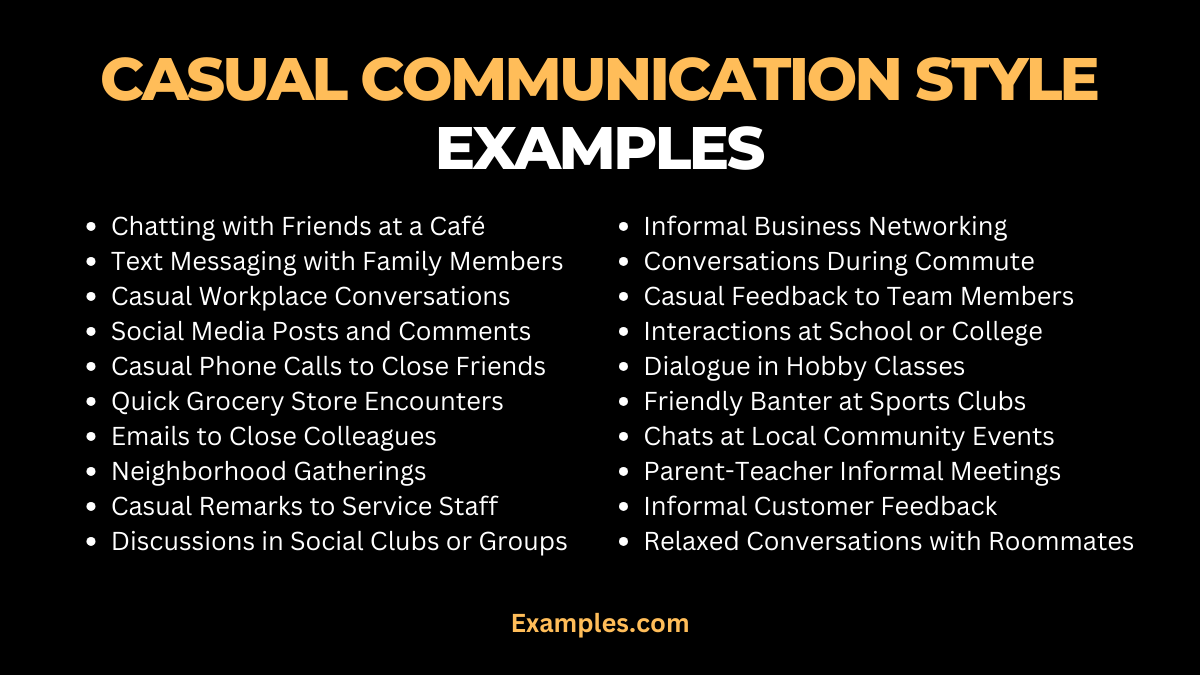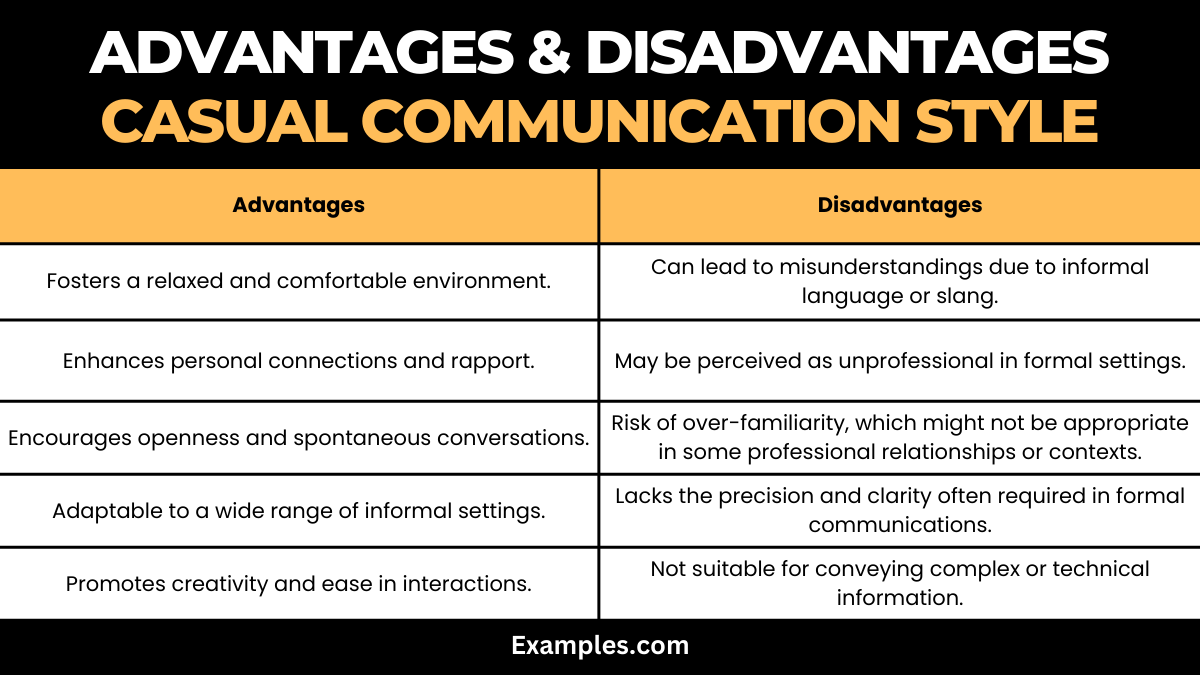19+ Casual Communication Style Examples
Casual Communication Style is a relaxed and informal way of interacting that’s prevalent in our everyday conversations. This complete guide offers a deep dive into the nuances of casual communication, enriched with real-world communication examples. It explores how this style functions in various settings, from personal chats to less formal business environments. Understanding the subtleties of casual communication, including its tone, context, and appropriateness, is crucial for effective and comfortable interactions in both social and professional spheres.
Download Casual Communication Style in PDFWhat is a Casual Style of Communication? – Definition

A Casual Style of Communication is a relaxed and informal way of exchanging information. It’s characterized by spontaneous and friendly conversation, often used in everyday interactions with friends, family, or colleagues. This style typically lacks the formalities and structure found in formal communication, making it more personal and approachable. In casual communication, the focus is on ease and comfort, allowing for a more open and genuine exchange of thoughts and ideas. It’s a common style in informal communication settings, where the environment is less strict and more laid-back.
20 Casual Communication Style Examples

Casual Communication Style is integral in everyday interactions, offering a relaxed and friendly way of exchanging thoughts and ideas. This guide presents 20 unique examples, showcasing the versatility of casual communication in various scenarios. From text messages to coffee break chats, these examples highlight the ease and comfort that define casual communication. Understanding how to effectively use this style in informal communication settings, whether in personal or less formal professional environments, enhances relatability and fosters stronger connections.
- Chatting with Friends at a Café
Casual talk about daily life and shared interests.
Example: “I loved the movie we saw last night. What did you think?” - Text Messaging with Family Members
Informal texts updating about personal life.
Example: “Had a great day at work! How was your day?” - Casual Workplace Conversations
Discussing non-work topics with colleagues during breaks.
Example: “I’m planning a weekend hike. You interested in joining?” - Social Media Posts and Comments
Sharing experiences and opinions online in a relaxed manner.
Example: “Just tried this new café downtown. Highly recommend it!” - Casual Phone Calls to Close Friends
Informal chats catching up on life events.
Example: “Hey, long time! We should catch up soon. What’s new?” - Quick Grocery Store Encounters
Exchanging pleasantries with acquaintances or neighbors.
Example: “Nice seeing you here! How’s everything going?” - Emails to Close Colleagues
Friendly and informal tone in professional correspondence.
Example: “Thanks for the help with the report. You’re a lifesaver!” - Neighborhood Gatherings
Light-hearted conversations at local community events.
Example: “This BBQ is great! Have you met our new neighbors yet?” - Casual Remarks to Service Staff
Friendly small talk with baristas, cashiers, or waitstaff.
Example: “Lovely weather today, isn’t it? Perfect for a coffee!” - Discussions in Social Clubs or Groups
Sharing hobbies and interests in a relaxed environment.
Example: “I’ve been getting into gardening lately. Got any tips?” - Informal Business Networking
Casual interactions at business events or meetups.
Example: “I heard about your recent project. Sounds fascinating!” - Conversations During Commute
Chatting with fellow commuters or carpoolers.
Example: “The traffic’s been crazy lately. Found any good shortcuts?” - Casual Feedback to Team Members
Offering informal, constructive feedback in a work setting.
Example: “I liked your presentation style, very engaging!” - Interactions at School or College
Casual talk with classmates about classes or activities.
Example: “Are you joining the study group this evening?” - Dialogue in Hobby Classes
Discussing mutual interests in a relaxed class setting.
Example: “Your painting really captures the mood of the scene!” - Friendly Banter at Sports Clubs
Light-hearted conversations during or after sports activities.
Example: “Great game today! You really improved your swing.” - Chats at Local Community Events
Engaging in informal discussions at neighborhood events.
Example: “The live band was amazing. Do you attend these often?” - Parent-Teacher Informal Meetings
Discussing a child’s progress in a non-formal setting.
Example: “Your child’s creativity in class projects is impressive!” - Informal Customer Feedback
Giving relaxed feedback in a store or restaurant.
Example: “Loved the new dish. I’ll definitely be back for more!” - Relaxed Conversations with Roommates
Talking about shared living spaces or plans.
Example: “Should we plan a movie night this weekend?”
Features of Casual Communication Style
The Casual Communication Style is a relaxed, informal mode of interaction that is prevalent in everyday conversations. This style is distinguished by several key features that set it apart from more formal communication methods.
Informal and Relaxed Tone
Casual communication is marked by an informal, relaxed tone. It is free-flowing and does not adhere to rigid structures or formalities, making it highly accessible and comfortable.
Use of Colloquial Language
This style often incorporates colloquial language, including slang and idioms, which makes it resonate more with daily conversations and personal interactions.
Personal and Engaging
Casual communication is personal and engaging, focusing on individual experiences and shared interests. It fosters a sense of closeness and familiarity between the communicators.
Nonverbal Expressiveness
Nonverbal cues like gestures, facial expressions, and tone of voice play a significant role in casual communication, adding depth and emotion to the conversation.
Flexibility and Adaptability
Casual communication is highly adaptable, fitting seamlessly into various informal contexts, from casual workplace interactions to social gatherings.
Context and Relationship Dependent
The appropriateness of casual communication largely depends on the context and the existing relationship between the parties involved. It’s common in friendly, informal settings but may not suit more formal or professional scenarios.
Advantages and Disadvantages of Casual Communication Style

While the Casual Communication Style is beneficial in many everyday contexts, it also has its drawbacks, particularly in situations that require a more formal approach.
| Advantages of Casual Communication Style | Disadvantages of Casual Communication Style |
|---|---|
| Fosters a relaxed and comfortable environment. | Can lead to misunderstandings due to informal language or slang. |
| Enhances personal connections and rapport. | May be perceived as unprofessional in formal settings. |
| Encourages openness and spontaneous conversations. | Risk of over-familiarity, which might not be appropriate in some professional relationships or contexts. |
| Adaptable to a wide range of informal settings. | Lacks the precision and clarity often required in formal communications. |
| Promotes creativity and ease in interactions. | Not suitable for conveying complex or technical information. |
Advantages
Enhances Comfort and Openness
Casual communication creates a relaxed atmosphere that encourages openness, making it easier for people to express themselves candidly.
Builds and Strengthens Personal Connections
Its informal nature fosters stronger, more personal connections, enabling individuals to bond over shared experiences and interests.
Promotes Creativity and Spontaneity
This style encourages spontaneous discussions, often leading to more creative and dynamic exchanges of ideas.
Versatile and Widely Applicable
Casual communication is versatile, suitable for a variety of informal contexts, from personal relationships to less formal business communications.
Disadvantages
Potential for Misunderstandings
The informal use of language, including slang, can sometimes lead to misunderstandings, especially in diverse cultural settings.
Inappropriateness in Formal Settings
Casual communication may not be suitable for formal or professional contexts, where a more structured communication style is expected.
Risk of Excessive Informality
There’s a risk of crossing the line into over-familiarity, which might not be appropriate in certain professional relationships or contexts.
Lack of Precision and Clarity
This style may sometimes lack the precision and clarity required in formal communication, leading to ambiguity or misinterpretation.
The Casual Communication Style, with its relaxed tone and personal touch, is a key component in effective informal communication. It is essential for building personal connections and facilitating open and spontaneous conversations. However, its application should be context-sensitive, balancing its informality with the need for clarity and appropriateness, especially in diverse or formal settings.
Appropriate to Use the Casual Style of Communication?
Determining the appropriateness of using the Casual Style of Communication largely depends on the context, the relationship between the individuals involved, and the purpose of the interaction.
In Personal Relationships
In personal relationships, such as with friends and family, casual communication is often the most appropriate. It allows for a relaxed and comfortable exchange, fostering closeness and familiarity.
Workplace and Professional Settings
In the workplace, casual communication can be appropriate in certain contexts. For instance, during informal team meetings, casual lunches, or while interacting with close colleagues, a casual tone can promote a friendly and collaborative atmosphere. However, it’s important to gauge the company culture and the nature of the event or interaction before choosing this style.
Social Media and Online Communication
Casual communication is widely accepted and often preferred in social media and other online interactions. Its informal nature aligns well with the relaxed and personal environment of these platforms.
Customer Service and Public-Facing Roles
For customer service or in public-facing roles, casual communication can be appropriate if it aligns with the brand’s tone and approach. It can make customers feel more at ease and create a more personable experience.
Cross-Cultural Interactions
In cross-cultural interactions, it’s crucial to be mindful of the other person’s cultural norms and communication styles. While casual communication might be commonplace in some cultures, it may not be appropriate in others where formal communication is valued.
Educational Settings
In educational settings, particularly in informal discussions or extracurricular activities, a casual style can encourage student participation and engagement. However, in more formal educational settings like lectures or presentations, a more formal style might be necessary.
In summary, while the casual style of communication is highly effective in creating a relaxed and open environment, its appropriateness largely depends on the context, the nature of the relationship between the participants, and the cultural norms of the environment. Balancing the informal nature of this style with the requirements of the situation is key to effective communication.
What is a Casual Way of Communication?
A casual way of communication is an informal and relaxed style of interaction, often characterized by personal, spontaneous, and emotive conversations.
What is a Casual Style Explanation?
Casual style explanation involves using informal, easy-to-understand language, often with colloquialisms or slang, to convey information in a relaxed and approachable manner.
Why is Casual Communication Style Important?
Casual communication style is important as it fosters a comfortable and open environment, encouraging honesty, creativity, and stronger personal connections in informal settings.
the casual communication style, with its informal, relaxed approach, is integral to fostering personal connections and promoting a comfortable environment for spontaneous conversations. It’s particularly effective in less formal professional environments and personal interactions, enhancing relatability and approachability. For further insights into effective interpersonal communication, the University of Colorado Boulder offers valuable resources at University of Colorado Boulder: Interpersonal Communication.
Additionally, understanding when to appropriately use casual communication is key, especially in diverse cultural contexts and formal settings. Mastering this balance can lead to more effective and meaningful interactions. The American Management Association provides further guidance on adapting communication styles to different settings, available at American Management Association: Communication Skills.
The Casual Communication Style plays a crucial role in fostering comfortable, open, and genuine interactions in less formal contexts. It enhances personal connections, encourages spontaneity, and adapts to various informal situations. While its relaxed nature is invaluable in many scenarios, understanding when and where to employ this style is key to effective communication, ensuring a balance between informality and appropriateness.



